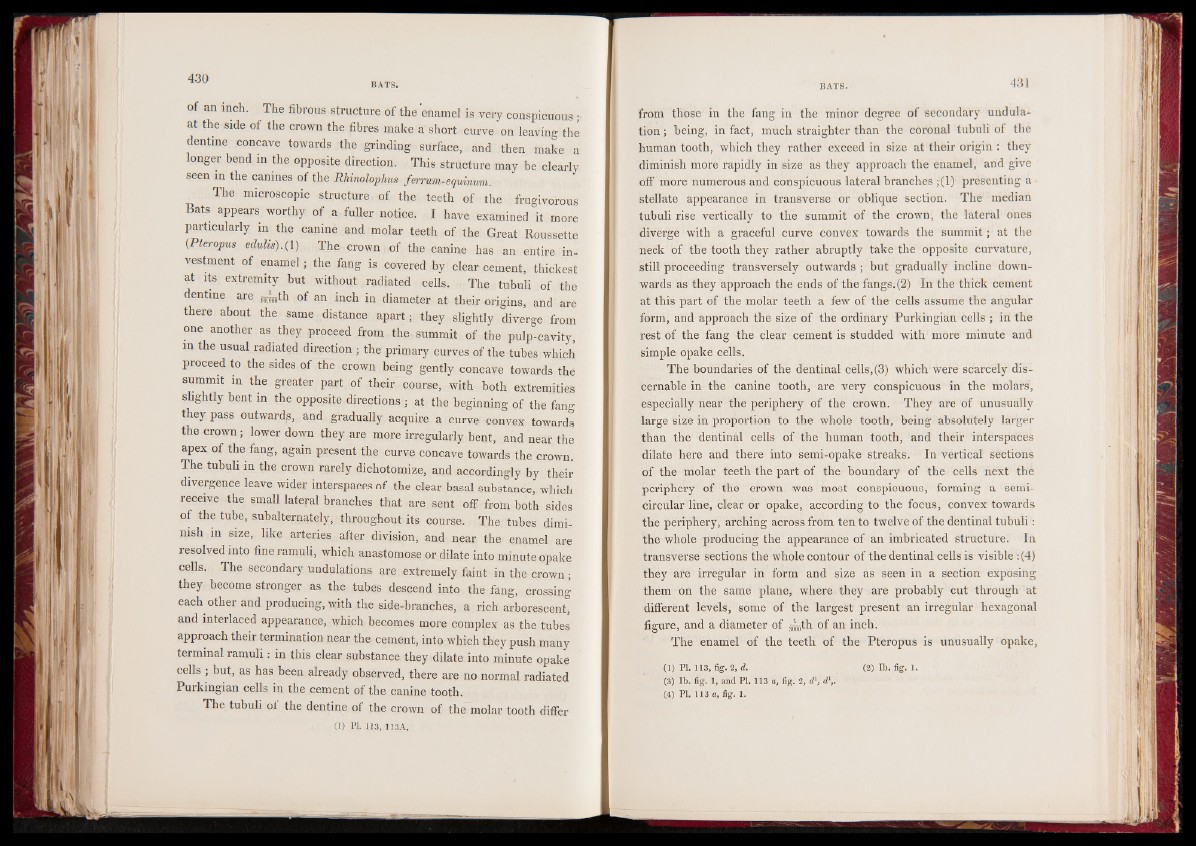
of an inch. The fibrous structure of the enamel is very conspicuous
at the side of the crown the fibres make a short curve on leaving the
dentine concave towards the grinding surface, and then make a
longer bend in the opposite direction. This structure may be clearly
seen in the canines of the Rhinolophus ferrum-equinum.
The microscopic structure of the teeth of the frugivorous
Bats appears worthy of a fuller notice. I have examined it more
particularly in the caninè and molar teeth of the Great Roussette
(Pteropus edulis).(l) The crown of the canine has an entire investment
of enamel; the fang is covered by clear cement, thickest
at its extremity but without radiated cells. The tubuli of the
dentine are ^ t h of an inch in diameter at their origins, and are
there about the same distance apart; they slightly diverge from
one another as they proceed from the summit of the pulp-cavity,
in the usual radiated direction ; the primary curves of the tubes which
proceed to the sides of the crown being gently concave towards the
summit in the greater part of their course, with both extremities
slightly bent in the opposite directions ; at the beginning of the fang
they pass outwards, and gradually acquire a curve convex towards
the crown; lower down they are more irregularly bent, and near the
apex of the fang, again present the curve concave towards the crown.
The tubuli in the crown rarely dichotomize, and accordingly by their
divergence leave wider interspaces of the clear basal substance, which
receive the small lateral branches that are sent off from both sides
of the tube, subalternately, throughout its course. The tubes diminish
in size, like arteries after division, and near the enamel are
resolved into fine ramuli, which anastomose or dilate into minute opake
cells. The secondary undulations are extremely faint in the crown;
they become stronger as the tubes descend into the fang, crossing
each other and producing, \yith the side-branches, a rich arborescent,
and interlaced appearance, "which becomes more complex as the tubes
approach their termination near the cement, into which they push many
terminal ramuli: in this clear substance they dilate into minute opake
cells ; but, as has been already observed, there are no normal radiated
Purkingian cells in the cement of the canine tooth.
The tubuli ol the dentine of the crown of the molar tooth differ
(i) in. ns, ii3A.
from those in the fang in the minor degree of secondary undulation
; being, in fact, much straighter than the coronal tubuli of the
human tooth, which they rather exceed in size at their origin : they
diminish more rapidly in size as they approach the enamel, and give
off more numerous and conspicuous lateral branches ;(1) presenting a •
stellate appearance in transverse or oblique section. The median
tubuli rise vertically to the summit of the crown, the lateral ones
diverge with a graceful curve convex towards the summit; at the
neck of the tooth they rather abruptly take the opposite curvature,
still proceeding transversely outwards ; hut gradually incline downwards
as they approach the ends of the fangs.(2) In the thick cement
at this part of the molar teeth a few of the cells assume the angular
form, and approach the size of the ordinary Purkingian cells ; in the
rest of the fang the clear cement is studded with more minute and
simple opake cells.
The boundaries of the dentinal cells,(3) which were scarcely dis-
cernable in the canine tooth, are very conspicuous in the molars,
especially near the periphery of the crown. They are of unusually
large size in proportion to the whole tooth, being absolutely larger
than the dentinal cells of the human tooth, and their interspaces
dilate here and there into semi-opake streaks. In vertical sections
of the molar teeth the part of the boundary of the cells next the
periphery of the crown was most conspicuous, forming a semicircular
line, clear or opake, according to the focus, convex towards
the periphery, arching across from ten to twelve of the dentinal tubuli:
the whole producing the appearance of an imbricated structure. In
transverse sections the whole contour of the dentinal cells is visible : (4)
they are irregular in form and size as seen in a section exposing
them on the same plane, where they are probably cut through at
different levels, some of the largest present an irregular hexagonal
figure, and a diameter of j^th of an inch.
The enamel of the teeth of the Pteropus is unusually opake,
(1) PI. 113, fig. 2, d. (2) lb. fig. 1.
(3) lb. fig. 1, and PI. 113 a, fig. 2, dl, d\.
(4) PI. 113 a, fig. 1.